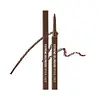CLIO Extreme Gelpresso Pencil Liner Versus Make Up For Ever Aqua Resist Color Pencil Full Impact Glide Waterproof Eyeliner
What's inside
What's inside
 Key Ingredients
Key Ingredients

 Concerns
Concerns

 Ingredients Side-by-side
Ingredients Side-by-side

Cyclopentasiloxane
EmollientTrimethylsiloxysilicate
EmollientCI 77499
Cosmetic ColorantSynthetic Wax
AbrasiveCI 77491
Cosmetic ColorantSilica
AbrasiveTrimethylsiloxysilicate/Dimethiconol Crosspolymer
Mica
Cosmetic ColorantSilica Silylate
EmollientMangifera Indica Seed Oil
EmollientCI 77492
Cosmetic ColorantCI 77510
Cosmetic ColorantPentaerythrityl Tetra-Di-T-Butyl Hydroxyhydrocinnamate
AntioxidantCyclohexasiloxane
EmollientCopernicia Cerifera Cera
EmollientCyclopentasiloxane, Trimethylsiloxysilicate, CI 77499, Synthetic Wax, CI 77491, Silica, Trimethylsiloxysilicate/Dimethiconol Crosspolymer, Mica, Silica Silylate, Mangifera Indica Seed Oil, CI 77492, CI 77510, Pentaerythrityl Tetra-Di-T-Butyl Hydroxyhydrocinnamate, Cyclohexasiloxane, Copernicia Cerifera Cera
CI 77499
Cosmetic ColorantTrimethylsiloxysilicate
EmollientSynthetic Wax
AbrasiveTrisiloxane
Skin ConditioningDimethicone
EmollientCera Microcristallina
Emulsion StabilisingC30-45 Alkyl Dimethicone
Skin ConditioningCI 77510
Cosmetic ColorantPhenylpropyldimethylsiloxysilicate
EmollientCI 77266
Cosmetic ColorantPolymethylsilsesquioxane
Mica
Cosmetic ColorantPolyhydroxystearic Acid
EmulsifyingDicalcium Phosphate
AbrasivePentaerythrityl Tetra-Di-T-Butyl Hydroxyhydrocinnamate
AntioxidantDisteardimonium Hectorite
StabilisingPropylene Carbonate
SolventSilica
AbrasiveCI 77400
Cosmetic ColorantCI 77000
Cosmetic ColorantCI 77891
Cosmetic ColorantSynthetic Fluorphlogopite
Calcium Aluminum Borosilicate
Calcium Sodium Borosilicate
Tin Oxide
AbrasiveCI 77499, Trimethylsiloxysilicate, Synthetic Wax, Trisiloxane, Dimethicone, Cera Microcristallina, C30-45 Alkyl Dimethicone, CI 77510, Phenylpropyldimethylsiloxysilicate, CI 77266, Polymethylsilsesquioxane, Mica, Polyhydroxystearic Acid, Dicalcium Phosphate, Pentaerythrityl Tetra-Di-T-Butyl Hydroxyhydrocinnamate, Disteardimonium Hectorite, Propylene Carbonate, Silica, CI 77400, CI 77000, CI 77891, Synthetic Fluorphlogopite, Calcium Aluminum Borosilicate, Calcium Sodium Borosilicate, Tin Oxide
Ingredients Explained
These ingredients are found in both products.
Ingredients higher up in an ingredient list are typically present in a larger amount.
Ci 77499 is also hydrated iron III oxide. It is created from mixing red and black iron oxides. This helps give shades of darkness to a product.
Iron III oxides are classified as inorganic chemicals for coloring.
This ingredient is used to impart a blue color. It is not water-soluble.
It goes by two different names:
1. Ferric Ferrocyanide: a synthetic dark blue pigment
2. Ferric Ammonium Ferrocyanide: a synthetic blue pigment, also called Prussian blue
In the EU, both of these colors must be labeled as 'CI 77510'.
Learn more about CI 77510Mica is a naturally occurring mineral used to add shimmer and color in cosmetics. It can also help improve the texture of a product or give it an opaque, white/silver color.
Serecite is the name for very fine but ragged grains of mica.
This ingredient is often coated with metal oxides like titanium dioxide. Trace amounts of heavy metals may be found in mica, but these metals are not harmful in our personal products.
Mica has been used since prehistoric times throughout the world. Ancient Egyptian, Indian, Greek, Roman, Aztec, and Chinese civilizations have used mica.
Learn more about MicaPentaerythrityl Tetra-Di-T-Butyl Hydroxyhydrocinnamate (long name, huh?) is a synthetic antioxidant.
It is used to help stabilize other antioxidants or prevent the color from changing in a product.
As an antioxidant, it helps fight free-radical molecules. Free-radical molecules are capable of damaging our cells and other genetic material. Thus, antioxidants may reduce the signs of aging.
This ingredient is oil-soluble.
Learn more about Pentaerythrityl Tetra-Di-T-Butyl HydroxyhydrocinnamateSilica, also known as silicon dioxide, is a naturally occurring mineral. It is used as a fine, spherical, and porous powder in cosmetics.
Though it has exfoliant properties, the function of silica varies depending on the product.
The unique structure of silica enhances the spreadability and adds smoothness, making it a great texture enhancer.
It is also used as an active carrier, emulsifier, and mattifier due to its ability to absorb excess oil.
In some products, tiny microneedles called spicules are made from silica or hydrolyzed sponge. When you rub them in, they lightly polish away dead skin layers and enhance the penetration of active ingredients.
Learn more about SilicaSynthetic Wax is created from fossil fuels such as natural gas. It is used to enhance texture, adjust pH, and as an occlusive.
It may also be used as an abrasive ingredient to exfoliate the skin.
Synthetic Wax may not be fungal acne safe.
Learn more about Synthetic WaxThis silicone is an emollient. Emollients create a thin film on the skin to prevent moisture from escaping.
It is not soluble in water and helps increase water-resistance in products.
According to a manufacturer, it can blend seamlessly with silicone oils, such as Cyclopentasiloxane.
Learn more about Trimethylsiloxysilicate